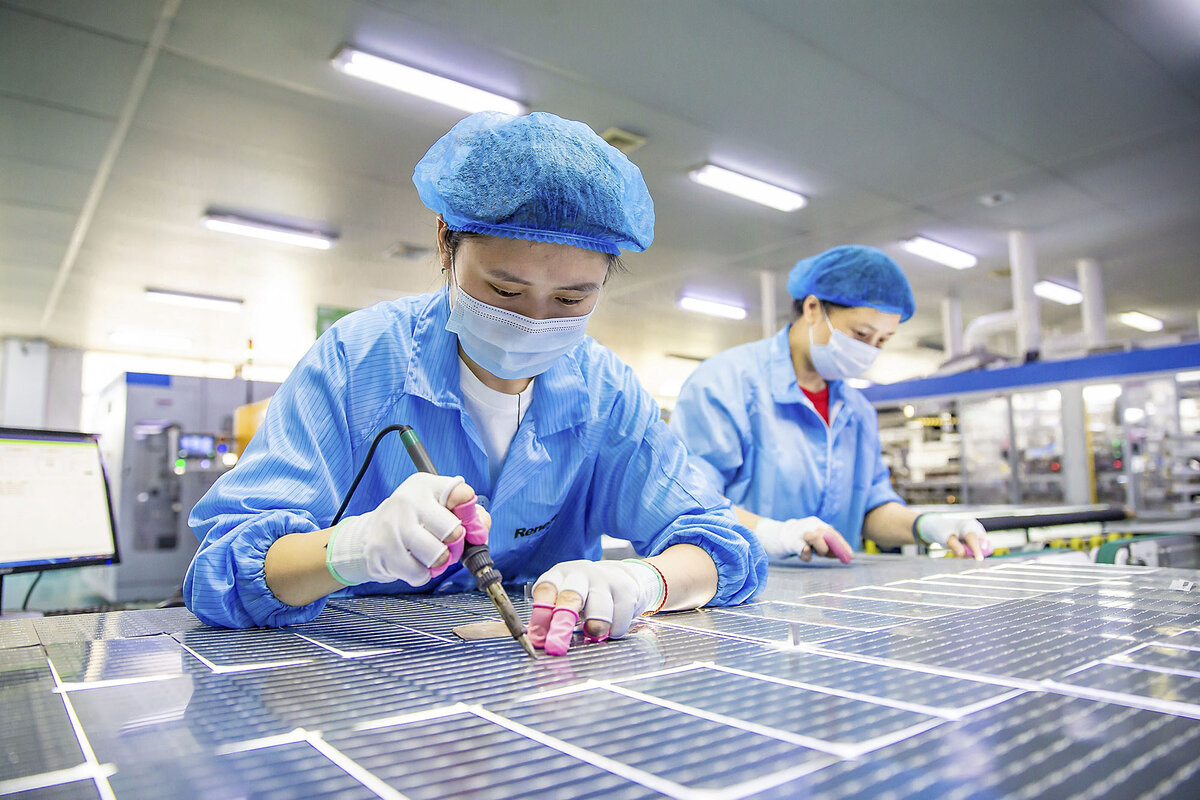What China’s renewable energy boom means for the world
Loading...
| Hefei, China
China made historic increases in installations of solar, wind, and other renewable energy in 2023, including adding 216 gigawatts of solar capacity. Experts say China’s rapid adoption of renewable energy is helping move the country – the world’s biggest emitter of heat-trapping gases – toward its climate goals faster than expected.
For example, China has committed to reaching its carbon peak by 2030, but some analysts say its emissions could peak as early as this year, and then start declining. This hinges partly on China’s ability to stabilize its surging energy demand, a significant portion of which is still being met by coal. China’s state-led market dominance in renewables is also provoking trade retaliation, with the United States raising tariffs this week on Chinese solar panels, electric vehicles, and other goods.
Why We Wrote This
China’s booming renewable energy industry may be stirring trade tensions, but it could also accelerate a green transition – in China and elsewhere.
Experts say Beijing’s investments in renewable energy benefit many countries that lack such industries, and note that trade barriers imposed by developed countries will create inefficiencies and increase costs, at least in the short term.
“In the long term, [the tariffs] could be somewhat positive because you get more distributed production, which might be more stable,” says Jan Ivar Korsbakken, a researcher in Oslo, Norway. “The issue, of course, is that we don’t have a lot of time.”
At a sprawling facility in eastern China, engineers and quality control workers in blue and pink uniforms monitor the heavily robotic assembly line for Sungrow Power Supply Co. Ltd.
The firm is one of the world’s biggest producers of solar inverters – equipment critical to making electricity from solar panels usable in grids. And its products are now sold in 170 countries, part of the explosion of China’s renewable energy industry that is fueling trade tension but also facilitating the shift to green power, here and overseas.
Flanked by ceiling-high video screens showcasing Sungrow’s clean energy capabilities, Senior Vice President David Zhao boasts that the company’s total installed capacity has exceeded 500 gigawatts globally. “This is a very great contribution” to the green energy transition, he says at the company’s headquarters in Hefei, China.
Why We Wrote This
China’s booming renewable energy industry may be stirring trade tensions, but it could also accelerate a green transition – in China and elsewhere.
Experts say China’s rapid adoption of renewable energy is helping move the country toward its climate goals faster than expected. Last year, China made historic increases in installations of solar, wind, and other renewable energy, including adding 216 gigawatts of solar capacity – more than what exists in the United States.
China – the world’s biggest emitter of heat-trapping gases, accounting for 35% of carbon emissions in 2023 – has committed to reaching its carbon peak by 2030 and carbon neutrality by 2060. But some analysts say its emissions could peak as early as this year, and then start declining. This also hinges partly on China’s ability to stabilize the country’s surging energy demand, a significant portion of which is still being met by coal.
“If the energy demand growth rates normalize and the green energy additions continue, then the first half of this year – so essentially right now – would be the peak,” says Lauri Myllyvirta, senior fellow at the China Climate Hub of the Asia Society Policy Institute. “There is no way to reach the global goals without a much faster peak in emissions in China,” he says. “It’s basically our only hope.”
An energy “tug of war”
While the expansion of renewables is promising, China’s overall climate trajectory remains uncertain. The country remains highly dependent on coal and continues to open new coal-fired plants.
“What has been happening in China is a tug of war between expanding renewables and growing overall power demand,” says Jan Ivar Korsbakken, senior researcher at the CICERO Center for International Climate Research in Oslo, Norway. “China has built out renewables, solar, and wind power generation at just an incredible pace, quite unprecedented.”
But electricity demand has also gone up, driven in part by new high-tech industries such as batteries, he says, illustrating the “very strong forces pulling in different directions.”
This tension could mean that even if China’s emissions do peak early, they are unlikely to drop steeply, and could plateau, Mr. Korsbakken says.
Meanwhile, China’s government-backed dominance of the international market for solar panels, batteries, electric vehicles, and other green energy technologies is sparking trade retaliation. The U.S., Europe, and other advanced economies are concerned that a flood of cheap imports will undermine domestic producers, and possibly create national security risks.
On Tuesday, the Biden administration announced it will double U.S. tariffs on Chinese solar panels to 50% and quadruple those on Chinese electric vehicles to 100%, effectively barring them from the U.S. market.
“China is determined to dominate these industries. I’m determined to ensure America leads the world in them,” President Joe Biden said on X. He also raised tariffs to 25% on Chinese steel and aluminum, and to 50% on Chinese EV batteries and semiconductors.
Beijing responded to the new tariffs by calling the move protectionist and hypocritical, hinting at possible retaliation. The Ministry of Commerce called the tariffs politically motivated and said they violate international trade rules, according to the state-run Xinhua News Agency.
China “will take all measures necessary to defend our legitimate rights and interests,” Foreign Ministry Spokesperson Wang Wenbin said at a press briefing Tuesday. “The fast-growing Chinese new energy industries are what the world economy needs for green transition.”
Green transition roadblocks
Indeed, experts say Beijing’s investments in renewable energy technologies and manufacturing benefit many countries that lack such industries, especially in the developing world. The trade barriers imposed by the U.S. and other developed countries will create inefficiencies and increase costs, at least in the short-to-medium term, says Mr. Korsbakken.
“In the long term, it [the tariffs] could be somewhat positive because you get more distributed production, which might be more stable and lend itself to faster expansion of renewables,” he says. “The issue, of course, is that we don’t have a lot of time.”
One problem with China’s dominance of renewable energy industries is the relatively high level of coal in its electricity mix – meaning its production of solar panels and other clean energy equipment creates more emissions than it would in the U.S. or Europe.
Even as China has outpaced the world in its use of renewable energy, it remains the globe’s biggest producer and consumer of coal, and has undergone a surge in coal consumption since 2020.
And China continues to build more coal-fired power plants, in part to help fill gaps in electricity supply when solar, wind, and hydropower are unavailable. Some Chinese provincial officials favor building coal-fired plants locally to ensure a steady electricity supply and boost gross domestic product for their province, as well as for coal mining as a source of local jobs.
“The biggest challenge for China at the moment is to stop creating more jobs, capacity, and capital tied to coal mining and coal-fired power plants and coal-based steel mills,” says Mr. Myllyvirta. Such expanded coal use, he says, will only “make the transition harder than it needs to be.”










